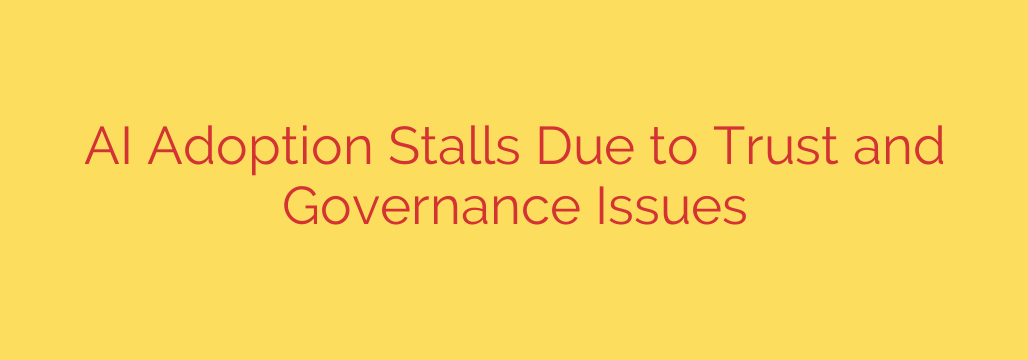
Why Is AI Adoption Stalling? The Hidden Barriers of Trust and Governance
The buzz around Artificial Intelligence is undeniable. From automating routine tasks to uncovering complex data insights, its potential seems limitless. Yet, despite the excitement, many organizations are hitting the brakes on wide-scale AI implementation. The reason isn’t a lack of ambition or technological capability; it’s a fundamental gap in trust, security, and clear governance.
While teams are eager to experiment with generative AI tools, leadership is grappling with the significant risks involved. This hesitation is creating a bottleneck, slowing down innovation and preventing businesses from realizing the full benefits of AI. Understanding these challenges is the first step to overcoming them and unlocking AI’s transformative power responsibly.
The Trust Deficit: Accuracy, Privacy, and Security Concerns
Before an organization can fully embrace AI, its leaders and employees must be able to trust it. Currently, several factors are eroding that trust, leading to cautious and limited adoption.
1. Data Privacy and Confidentiality Risks
One of the most immediate fears is data leakage. When employees use public generative AI models, they may inadvertently input sensitive information, such as proprietary code, customer data, or confidential strategic plans. This data can potentially be used to train future models, exposing it to the public domain or competitors.
Without clear policies, organizations are vulnerable to “Shadow AI,” where employees use unapproved, third-party AI tools without oversight from IT or security teams. This practice significantly increases the risk of data breaches and compliance violations.
2. The Problem of Inaccuracy and “Hallucinations”
Large Language Models (LLMs) are incredibly powerful, but they are not infallible. They are known to produce “hallucinations”—confident, articulate, but completely fabricated information. Relying on these inaccurate outputs for critical business decisions, from financial forecasting to engineering specifications, can have disastrous consequences.
Furthermore, AI models can inherit and amplify biases present in their training data. This can lead to skewed, unfair, or ethically questionable outcomes in areas like hiring, marketing, and customer service, creating significant reputational and legal risks.
The Governance Gap: Operating in an Unregulated “Wild West”
Beyond trust, the single biggest barrier to enterprise AI adoption is the absence of a formal governance framework. Many companies are in a reactive mode, lacking the policies and structures needed to manage AI’s introduction safely and effectively.
Key governance challenges include:
- Lack of Clear Ownership: Who is responsible for AI? Is it the CIO, a chief data officer, or a new AI-specific ethics committee? Without defined roles, accountability is diffused, and no one is empowered to create and enforce the necessary rules.
- Absence of an Acceptable Use Policy (AUP): Employees need clear guidelines. What tools are they allowed to use? What kind of data is permissible to input? What are the specific use cases that have been approved? An AUP is essential for setting clear boundaries and minimizing risk.
- Navigating the Evolving Legal Landscape: The regulatory environment around AI is still taking shape. Companies are hesitant to invest heavily in systems that might soon be rendered non-compliant by new laws regarding data privacy, transparency, and accountability.
A Roadmap for Safe and Strategic AI Adoption
Slowing down isn’t a long-term solution. The key is to move forward with intention and control. By establishing a robust governance framework, organizations can build the trust necessary to innovate safely.
Here are actionable steps to build a foundation for successful AI integration:
Establish a Cross-Functional AI Governance Committee: Assemble a team with representatives from IT, security, legal, HR, and key business units. This group should be tasked with evaluating risks, vetting tools, and creating a company-wide AI strategy.
Develop and Communicate a Clear AI Policy: Don’t leave employees guessing. Create a formal policy that outlines which AI tools are approved, defines what constitutes confidential data, and provides clear do’s and don’ts for AI usage. This policy should be a living document, updated as the technology and regulations evolve.
Prioritize Employee Education: Your people are your first line of defense. Conduct training sessions to educate all employees on the risks and benefits of AI. Teach them how to use approved tools effectively and how to identify and avoid potential security and privacy pitfalls.
Start with Low-Risk, High-Impact Pilot Projects: Instead of a company-wide free-for-all, identify specific, controlled use cases where AI can provide value without putting sensitive data at risk. Use these pilot programs to learn, refine your policies, and build internal confidence.
Thoroughly Vet AI Vendors and Tools: Before integrating any third-party AI service, scrutinize its security protocols, data handling policies, and privacy features. Opt for enterprise-grade solutions that offer data encryption, private instances, and clear contractual protections.
By proactively addressing the core issues of trust and governance, businesses can transform AI from a source of anxiety into a powerful and strategic asset for growth and innovation.
Source: https://go.theregister.com/feed/www.theregister.com/2025/10/01/gartner_ai_agents/








